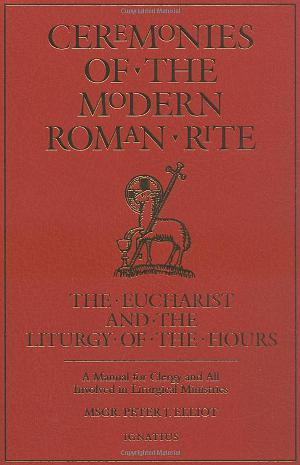 De siste ukene har det vært en del diskusjon (på nettet) om den såkalte «reformen av (liturgi)reformen», og noen sier at denne reformen er død etter at pave Benedikt gikk av. Andre sier at en «reform» av messefeiringen ikke kan bli en reform av rubrikkene (i alle fall ikke i med det første), men heller en forandringen mht hvordan messen i praksis feires – og her har det skjedd mye de siste årene.
De siste ukene har det vært en del diskusjon (på nettet) om den såkalte «reformen av (liturgi)reformen», og noen sier at denne reformen er død etter at pave Benedikt gikk av. Andre sier at en «reform» av messefeiringen ikke kan bli en reform av rubrikkene (i alle fall ikke i med det første), men heller en forandringen mht hvordan messen i praksis feires – og her har det skjedd mye de siste årene.
Biskop Peter J. Elliott skrev nettopp om dette på NLM-bloggen, og der minner han også om en bok han skrev for 20 år siden: «Ceremonies of the Modern Roman Rite». Jeg kjøpte boka for 15 år siden og leste den flere ganger ganske grundig, og lærte mye. (Den påvirket meg en hel del de første årene som prest, selv om jeg de sist 6-7 årene har blitt enda mer påvirket av at jeg nå også har lært å feire den tradisjonelle messen – det påvirker hvordan man feirer også den nye messen.) Slik skriver Biskop Elliott om hvordan messefeiringen bør reformeres:
I have become uneasy with the words “reform of the reform”. It is hard to find a better expression, “enrichment” perhaps. But now that the concept and project of the reform of the reform is under attack in NLM, let me speak frankly. Permit me to offer counsel to those who announce the total failure of the post-conciliar liturgical reform, claiming that a reform of it is impossible and insisting that the Extraordinary Form is the only answer.
Let us be realistic. If you want the Extraordinary Form to become the Ordinary Form, reflect on the millions of people who come to vernacular Masses in our parishes around the world, in many countries and cultures. Would they easily embrace a Latin Low Mass with a server answering? And let us not forget the priests. This is why some pastoral realism is required. But let me put out a challenge – a reform of the Extraordinary Form would first be required – and I note that this has been suggested in terms of the Vatican Council’s “full, active and conscious participation.”
We know what that reform would look like. We already have it at our fingertips. It would be a Latin dialogue Mass, said or sung ad orientem, with the readings in the vernacular. Then questions arise about some other changes set out in Sacrosanctum Concilium. In the context of the wider Church another issue inevitably emerges: could the Extraordinary Form be said or sung in the vernacular? … …
Some might argue that, in the Anglophone world, the Novus Ordo has been rescued by the better ICEL translations. Mass not only sounds different but the atmosphere in our churches has undergone subtle and positive changes. Of course I do not refer to parishes where the priest still babbles or barks, or to celebrants who play with the liturgy, a few even exhuming the 1998 ICEL texts.
What needs to be discerned is whether this re-sacralising trend will endure and develop, for it is a major achievement of the reform of the reform that can be traced back to Blessed John Paul II (the Vox Clara committee), then developed so well by Benedict XVI in his wider project. This is why I do not want to see the gains of the reform of the reform project, fragile as it often is, broken or derided by triumphalist rhetoric, or pushed aside by an impatience that dismisses the whole Paul VI reform as beyond salvation.
Twenty years ago, while working in the Roman Curia, I began writing Ceremonies of the Modern Roman Rite. At a Una Voce meeting in Rome, I told the late Mme de Saventhem of my project to present Novus Ordo ceremonial precisely, interpreted according to the continuity with our tradition. With disarming charm the gracious lady exclaimed, “My dear Monsignor, that is an impossible task!”
Well, impossible or not, Ceremonies of the Modern Roman Rite appeared, and was immediately denounced or ignored by the US liturgical establishment. An angry priest from Eyrie PA even claimed it was out of print. However, gradually the book emerged from concealment in seminarians’ cupboards, and now it may be found on top of their desks, and it is even cited in class by their professors. So those of us who have already worked for elements in a practical reform of the reform can see some progress, slow but steady, and welcomed by the young. …..
